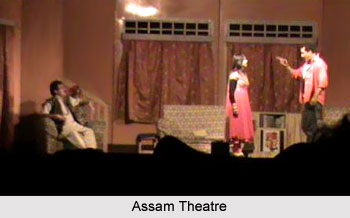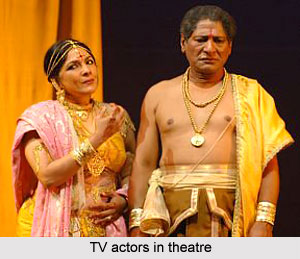 Assamese theatre boasts of rich and valuable history. There are various types of Assamese theatre which has been composed by reformers of Vaishnava like Madhavadeva and Sankaradeva that have been successfully staged in community halls known as "nam-ghar". There are many modes of performance like Bhaoriya, Dhuliya, and Oja-Pali.
Assamese theatre boasts of rich and valuable history. There are various types of Assamese theatre which has been composed by reformers of Vaishnava like Madhavadeva and Sankaradeva that have been successfully staged in community halls known as "nam-ghar". There are many modes of performance like Bhaoriya, Dhuliya, and Oja-Pali.
Origin of Assamese Theatre
Assamese theatre, which first appeared in Guwahati, drew all its initial ingredients from the theatre of western mould with proscenium stage and Anglo-European dramatic structure. This was the forty nine years after the annexation of the state of Assam. The education and exposure to Bengali theatre at Kolkata, during higher studies, inspired many students from new generation into Assamese. This wave occurred in the 19th century and also motivated the youth to make theatre in Assamese language, which became famous instantly and moved entire state of Assam.
History of Assamese Theatre
In the initial years, performances in Assamese theatre were held on a temporarily erected stage. Permanent structures came up in the 1890s and with the onset of second decade of 20th century, all sub divisional towns and districts, including semi urban places, had at least one theatre. However, it was neither daily, nor weekly, nor even monthly fare.
Generally plays are performed during important occasions or festivals or just for pleasure of putting up a show. Till this day, apart from the recent touring repertory companies known as Bhramyaman Mancha i.e. "mobile theatre", no group performs daily or weekly on a regular basis. This occurred in spite of the fact that, previously, people made unsuccessful attempts. Yet, there are shows that take place daily, in cultural capital, Guwahati, by one group or the other.
History of Assamese Plays
 Although proscenium theatre arrived in the year 1875, playwriting for modern Indian theatre commenced eighteen years earlier. The first play, Gunabhiram Barua`s Ram-Navami i.e. a festival devoted to Lord Rama on widow remarriage, was written in 1857. The next one was a satire, named Kania Kirtan i.e. "Kirtan to Opium" in 1861. Bordoloi, in the year 1871-72, wrote Bongal-Bongalani or "Bengali Couple", a social farce, satirizing lascivious concubines and promiscuous women who married non-Assamese outsiders. There is, however, do document proof, regarding it these plays were ever staged. And it is also not known for certain with which play Assamese theatre raised its curtain.
Although proscenium theatre arrived in the year 1875, playwriting for modern Indian theatre commenced eighteen years earlier. The first play, Gunabhiram Barua`s Ram-Navami i.e. a festival devoted to Lord Rama on widow remarriage, was written in 1857. The next one was a satire, named Kania Kirtan i.e. "Kirtan to Opium" in 1861. Bordoloi, in the year 1871-72, wrote Bongal-Bongalani or "Bengali Couple", a social farce, satirizing lascivious concubines and promiscuous women who married non-Assamese outsiders. There is, however, do document proof, regarding it these plays were ever staged. And it is also not known for certain with which play Assamese theatre raised its curtain.
The first mythological drama was known as "Sita Haran" i.e. Stealing Sita by Rama Kanta Chaudhury in the year 1875. Without any exceptions, all plays that were written later in the 19th century belonged to this genre. During that time, Bhaona was the most popular traditional Assamese theatre form. These drew all the plots from mythological ideas like Ramayana, Mahabharata and the Puranas. It was perhaps natural in the transition from traditional theatre to the new variety to retain the content. Mythological drama dominated till about 1920, though it survived till the 1940s, as in Atulchandra Hazarika`s plays.
Early Assamese drama of this age was in blank verse modelled on the Bengali "Amitrakshar Metre", (sonnet) containing fourteen syllables in each line. Playwrights later broke these barriers by adopting the "Gairish Metre", a kind of free blank verse popularized by the Bengali actor-manager, and father of Bengali theatre - Girish Ghosh. The prose dialogue was introduced, in 1903, by Benudhar Rajkhowa in his Duryodhanar urubhanga i.e. "Duryodhana`s Broken Thigh". There was mutual co-existence between Historical drama and theatres derived from mythological ideas twentieth century.
The Ahom period of Assamese history became a source of most historical drama, and it provided many heroes and martyrs i.e. men and women. Two among them, were particularly holy, on whom numerous works have been written - e.g. Jaymati and Lachit Barphukan. Jaymati was an Ahom princess that chose torture and death rather than discloses the whereabouts of her fugitive husband. Lachit Barphukan, a successful Ahom general, twice defeated the army of Mughal Empire between 1667 and 1671. His heroics and patriotism are legendary.
Modern Assamese Theatre
Era of modern social theatre may be considered from 1950. Plays related to social issues were written before 1947, but the number was low. Mostly, playwrights concentrated on, issues related to national awakening and reform against the British rule in India. After India gained independence, playwrights extended their creative horizon into political problems, class struggle, the caste system, conflict between generations, erosion of values, communal tensions, enmity between tribals and non-tribals, unemployment, disintegration of the joint family, hopes and frustrations of the middle class, and individual psychological conflicts. All of the subjects were very modern and contemporary. One-act play or drama holds a special position in Assamese theatre, and post mid-1950s, actors, writers and playwrights felt attracted to it. It gained immense popularity, during the 1960s, and even overshadowed full-length plays. The modern Assamese theatre also saw the induction of females for plays and acting. They started performing alongside men.
The expression for the first phase in theatre after the independence of India mainly dealt with naturalism. Slowly, as the contact established and popularized with the neo-modern playwrights from the rest of India as well as classics by Gogol, Gorky, Ibsen, Chekhov, Sartre, Beckett, Camus, Brecht and Ionesco, novelty in form and content became distinctly visible in the work of Arun Sarma and some more. The current act, in keeping with rest of nation, is to use local folk and traditional forms. The interface of theatre with cinema has also created some star performers, notably Phani Sarma, and creative directors like Dulal Roy, etc.
As the history of Assamese theatre suggests that, previously, for theatres, stages were lit with candles. With time and passing of years, it got lighted by hanging rows of kerosene lamps, gaslight or pressure lamps of brand name Petromax. These used to emit bright light. With the coming of age technology like power generators, theatres were used to light up until the injection of electricity in 1920s. Even then, electricity was used in certain important towns. The entire process of electrification in the state of Assam actually started only after independence of India. Before the 1930s, the stage decorations became a crucial part, with drapes and painted screens. Later of course, there were usages of flats along with painted screens. There are little attempts at realism by using three-dimensional set pieces. However, as in 1940s, with realistic scenography making its entry painted backdrops were done away with. Stylized sets, even bare stages, have served as theatre designs of late. Costumes were usually hired from agencies that specialized in renting them out. But in 1950s, when mythological and historical plays gave way to realistic social drama, this practice was more or less abandoned and costumes started to be specially intended for each production.




















